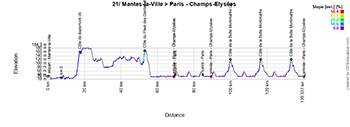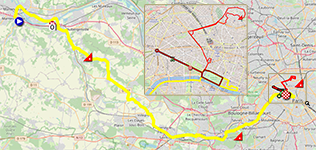Every year we hear the same question: "why is there always and still this 'turning around' on the Paris stage of the Tour de France?". It took the Paris 2024 Olympic Games and its incredible effervescence at rue Lepic on the climb up to the Buttée de Montmartre for that to change!
So it's against the backdrop of the 50th anniversary of the Tour de France's first arrival on the Champs-Elysées that the Tour de France 2025 introduces a new circuit that takes its inspiration from last summer's Olympic Games and will restore interest and perhaps even suspense to this final stage. Even if it's not out of the question for a sprinter to win it, the classics riders will have their sights firmly set on this stage!
Even though it has only just been officially revealed, velowire already presents you the the detailed route, which can be zoomed in on at will, so you can start thinking about July 27 right now!
CONTINUE READING AFTER THIS ADVERTISEMENT
A preview for testers of the velowire mobile app!
As will henceforth be the systematic case for detailed maps on OpenStreetMap, testers of the velowire mobile app on Android (the iOS test should follow shortly, so don't hesitate to sign up here if you want to be among the first to know) have been given access to the detailed map of this stage as a preview. It's actually a little easier to publish a map in the application, in which you benefit from more unique features such as the display (and tracking) of your location on the race map, than it is to publish an article on the site.Convinced? Install the application now on your Android smartphone or tablet from the Play Store!

Want to find out more?
>> Discover the presentation of the velowire app and its functionalities
We have to tell you ... as the app is still in the testing phase, there are a few known limitations/problems which will be resolved over the coming weeks!
Let's now get back to the last stage of the Tour de France 2025!
An anniversary on the Champs-Elysées: the 50th anniversary of the Tour's first arrival on the world's most beautiful avenue
Let's start with a bit of history. It's said that the Tour de France, with the exception of the Tour de France 2024, precisely because of the Paris 2024 Olympic Games, has always arrived in Paris. However, to be really precise, in 1903 and 1904 the first two editions of the Tour de France had their finishes in Ville-d'Avray, south-west of the capital. It was also there that the last stage of the 2003 Tour de France centenary took place, as well as the actual start of the last stage of the 2015 Tour de France (which left from Sèvres).From 1905 to 1967, the finish of the race, which grew in popularity year on year, moved to the Parc des Princes in western Paris, which at the time housed a velodrome. Then, for just a few years - from 1968 to 1974 - the Tour de France final finish was held at the Vélodrome de la Cipale in the Bois de Vincennes, to the east of the city, before... a "final" move to the Champs-Elysées in 1975.
This year marks the 50th anniversary of the Tour de France's final finish on the Champs-Elysées in Paris, with the exception of 2024. It will also be the 50th anniversary of Bernard Thévenet's first overall victory in the Tour de France (before his second in 1977).
CONTINUE READING AFTER THIS ADVERTISEMENT
With an Olympic flavour, the Tour explores the Butte Montmartre after Paris 2024
In 2024, the Tour de France was thus forced to snub Paris for its final finish, arriving in Nice. But a few weeks later, the capital was still spoiled for cycling, with time trials and also road races. And it was for the latter that both the men's and women's races visited Montmartre and its now-famous cobbled rue Lepic, where the crowds were out in force, cheering on the riders, even on the stairs in front of the Sacré Coeur.More precisely, this stage will start from Mantes-la-Ville and head directly east, south-east to be precise. 61.6 kilometers separate the riders from the first crossing of the finish line, and it's the 60-odd kilometers that will be used for a little parade, champagne glass in hand for the winner and his team-mates, and this will be notably between the two climbs that lie on this route. Soon after the start, they'll be climbing the Côte de Bazemont (4th category, 1.7 km at 7%), whose summit will be reached after just 10 kilometers from the actual start of this stage. The route then continues south-eastwards to Saint-Cyr-l'Ecole, where an easterly section will follow, past the Château de Versailles and on to Viroflay, where the northeasterly ascent towards Paris begins. After passing through Chaville, they turn onto the Côte du Pavé des Gardes, also a 4th-category climb (700 m at 9.7%). Passing through Issy-les-Moulineaux, and past the Orange headquarters opposite those of Amaury Sport Organisation in Boulogne-Billancourt (Orange, which will no longer be a partner of the Tour de France!), they then follow the Seine, leaving it on their left and passing in front of the Eiffel Tower (which will bring back fond memories for a certain Remco Evenepoel, even if the photo of him with the Tower was difficult to take, if he couldn't be a very tiny guy on the picture and at the same time have the Tower in its whole on it), the Musée du Quai Branly, the Palais de l'Alma, Invalides and the Pont Alexandre III as well as the Quai d'Orsay, they then finally turn left onto the Pont de la Concorde to join the first final circuit.
As usual, they then turn right to follow the Quai des Tuileries and push on past the Louvre, finally turning left and left again to enter the Cour Carrée du Louvre and pass by the Louvre Pyramid (as has become customary since 2013) before rejoining the Rue de Rivoli and heading via the Place de la Concorde towards the Champs-Elysées. At this point, the yellow section of the course ends, to be followed by the first final circuit, drawn in black, which winds its way up the Champs-Elysées all the way to Place Charles de Gaulle-Etoile, before heading back down the Champs-Elysées to Place de la Concorde and pushing on again along the Tuileries, this time turning left more quickly to pass through the small tunnel back to Rue de Rivoli.
The route of stage 21 of the Tour de France 2025 on an OpenStreetMap map and stage profile
Below you'll find the profile of this 21st and final stage of the Tour de France 2025, as well as its detailed route on an OpenStreetMap map. Click on the images to open them.

Vond u dit artikel interessant? Laat het uw vrienden op Facebook weten door op de buttons hieronder te klikken!
no comments yet | 13574 views
this publication is published in: Tour de France | Tour de France 2025 | OpenStreetMap/Google Maps/Google Earth





 by Thomas Vergouwen over
by Thomas Vergouwen over